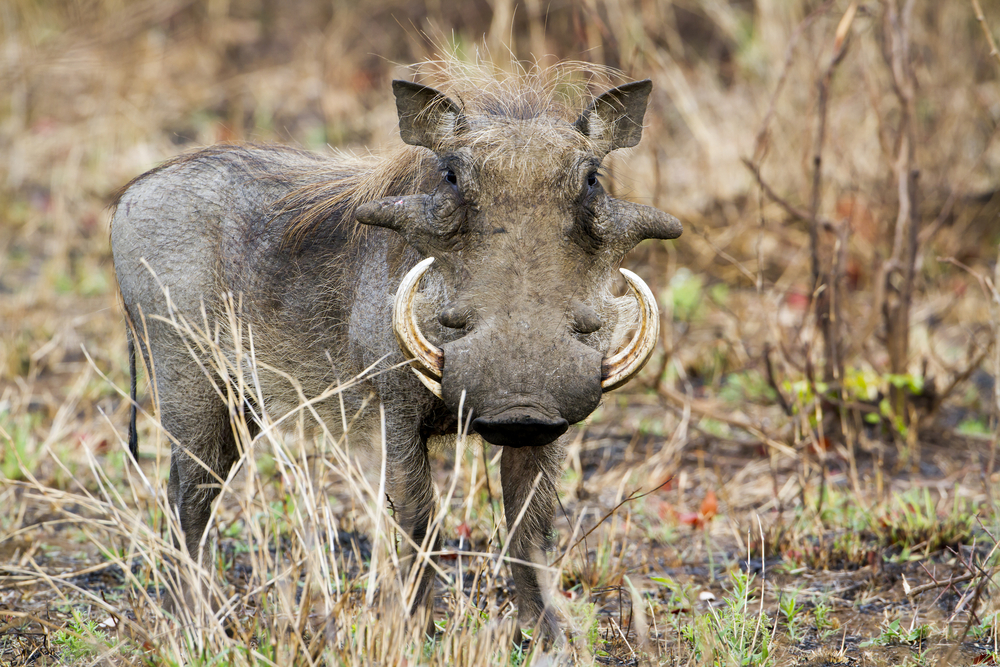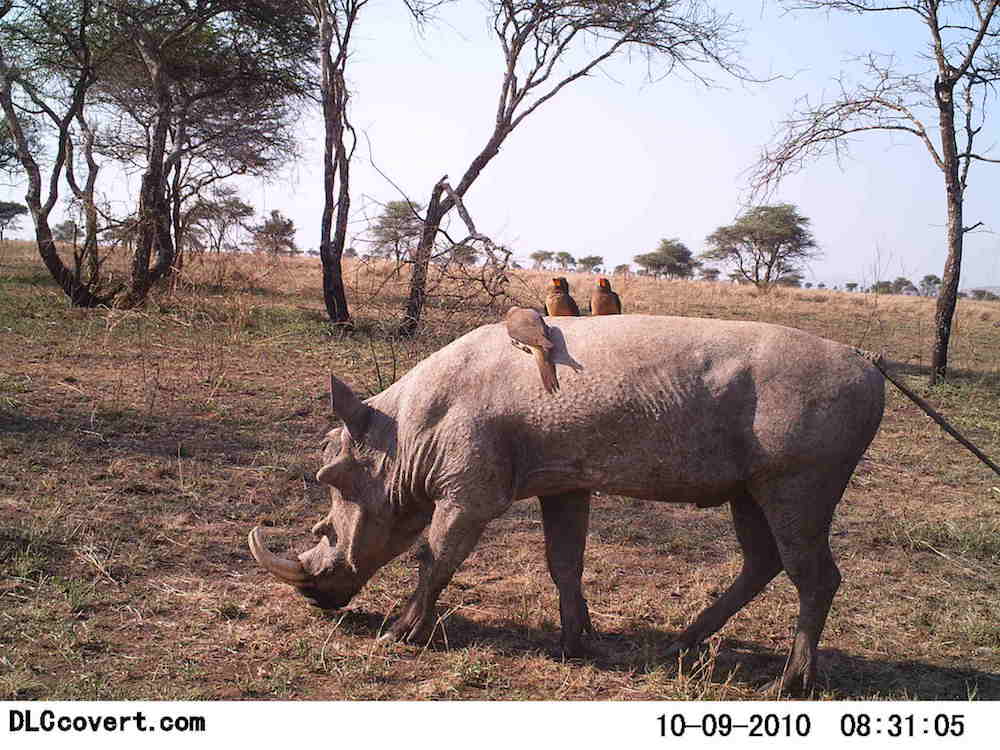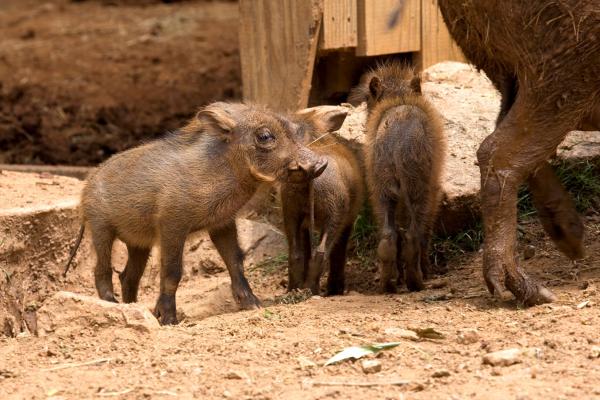Facts About Warthogs

Warthogs, as one might guess from the name, are members of the Swine family and are related to pigs, boars and hogs. And as the name also suggests, warthogs have patches on their faces that look like warts, but are just thick growths of skin. These patches act as padding for when males fight during mating season.
Size
Like their relatives, warthogs are plump, hooved animals with large nostrils at the end of the snout. They have little fur, except for a mane that goes down the spine to the middle of the back, according to the Animal Diversity Web (ADW). Their tails also end with a tuft of hair.
They have large teeth or tusks. Common warthogs have two upper and four to six lower incisors, according to ADW, while desert warthogs lack incisors. The upper tusks grow up to 10 or 11 inches (25 to 30 centimeters) long, according to the San Diego Zoo.
From hooves to shoulders, warthogs are around 30 inches (36 centimeters) tall and 35 to 59 inches (89 to 150 cm) long from shoulders to rump. They weigh a hefty 120 to 250 lbs. (54 to 113 kilograms). Common warthogs are slightly larger than desert warthogs.

Habitat
Common warthogs live in the grasslands and savanna woodlands of Africa. They prefer open areas, and are found on Mount Kilimanjaro at an elevation of 3,000 meters (9,843 feet), according to ADW. Desert warthogs are found in eastern Africa — in parts of Kenya, Somalia and Ethiopia.
Warthogs live in dens made by aardvarks. They don't fight for the holes, though. Warthogs are generally passive and look for already abandoned dens to make their homes.
Habits
Female warthogs, called sows, are social animals and live in groups called sounders, which can contain up to 40 members, according to the San Diego Zoo. Females groom each other and huddle together at night for warmth. Adult males aren't as social and can be territorial. Often, they live alone.
In general, warthogs forage during daybreak and the twilight hours. If they live in a dangerous area, they forage at night.
Diet
Warthogs are often perceived as vicious animals that attack and eat prey. Actually, warthogs are herbivores, which means they eat vegetation, according to ADW. A warthog's diet includes roots, berries, bark, bulbs, grass and plants. During times of scarcity, warthogs may eat meat, but they don't hunt. They munch on dead animals, worms or bugs they find as they forage.
In a dry season, these animals can go months without water, according to National Geographic.

Offspring
Female warthogs have up to eight young at a time, though they usually only have two or three, after a gestation period of around six months. Baby warthogs are called piglets. Piglets weigh around 1 to 2 lbs. (450 to 900 grams) at birth, according to the San Diego Zoo.
The young live with their mother in her sounder. Piglets are weaned around 4 months old and become mature at 20 months. Females tend to stay with their mother as adults, while males tend to go off on their own. Warthogs live 12 to 18 years.
Classification/taxonomy
Here is the taxonomy information for warthogs, according to the Integrated Taxonomic Information System (ITIS):
Kingdom: Animalia Subkingdom: Bilateria Infrakingdom: Deuterostomia Phylum: Chordata Subphylum: Vertebrata Infraphylum: Gnathostomata Superclass: Tetrapoda Class: Mammalia Subclass: Theria Infraclass: Eutheria Order: Artiodactyla Family: Suidae Subfamily: Suinae Tribe: Phacochoerini Genus: Phacochoerus Species: Phacochoerus africanus (common warthog), Phacochoerus aethiopicus (desert warthog) Subspecies:
- Phacochoerus africanus aeliani (Eritrean warthog)
- Phacochoerus africanus africanus (Northern warthog)
- Phacochoerus africanus massaicus (Central African warthog)
- Phacochoerus africanus sundevallii (Southern warthog)
- Phacochoerus aethiopicus aethiopicus (Cape warthog)
- Phacochoerus aethiopicus delamerei (Somali warthog)
Conservation status
The International Union for Conservation of Nature lists warthogs as least concern on their Red List of Threatened Species. They received this listing because they are widespread in their home areas and have a high reproduction rate.
Other facts
Warthogs can run up to 30 mph (48 km/h). Their speed helps them outrun predators. They zoom right to their dens and enter rear first, with their tusks sticking out of the entrance for added security.
During the rare times a warthog decides to face an attacker instead of hiding in their den, it will slash at the attacker with its tusks and bite with its sharp teeth.
Oxpeckers and other birds ride on warthogs and eat insects off their bodies. Warthogs will also wallow in mud to get rid of insects and to cool down on a hot day. Like pigs, warthogs don't have sweat glands to cool themselves.
Warthogs also have padding on their knees. They often kneel to eat lower grasses or to slurp up a bug.
Additional resources
Sign up for the Live Science daily newsletter now
Get the world’s most fascinating discoveries delivered straight to your inbox.











